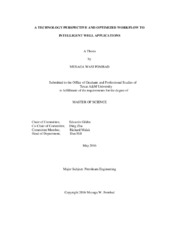| dc.description.abstract | Today’s oil and gas industry is faced with several geographic and economic challenges that have significantly increased the pressure on companies engaged in oil and gas exploration and production. Technical as well as economic challenges like the highly volatile crude oil prices, global competition for depleting resources and pressure from shareholders for return on investment are threatening to the industry. In the quest to address these challenges, operators are continuously seeking advanced technology that could increase production, improve recovery, and minimize cost. Although advanced technology such as 3D and 4D seismic downhole sensors have significantly improved the amount of accessible realtime information, the amount of data is often massive and too complex to accurately analyze.
Within the past decade, significant advances in drilling and completion techniques have been made to enable more active monitoring and control of production wells. Smart well technology, also known as Intelligent Well Completions (IWC), is one of such technologies that integrates permanent downhole sensors with surface-controlled downhole flow control valves, enabling operators to monitor, evaluate, and actively manage production (or injection) in real time. All of this is achieved without any well interventions, thus completely eliminating the risk and economic losses associated with well intervention.
A comprehensive review of smart well technology, as well as real-world case studies will be presented. A case study simulation is performed to evaluate the additional value that is derived by adopting smart well technology. The simulation results clearly indicate that adopting smart well technology significantly reduced field water cut, accelerated the productions time and improved the Net Present Value (NPV) of the project.
Finally, a workflow is presented which can be used to assess to applicability of a given field with multiple producing wells. | en |


